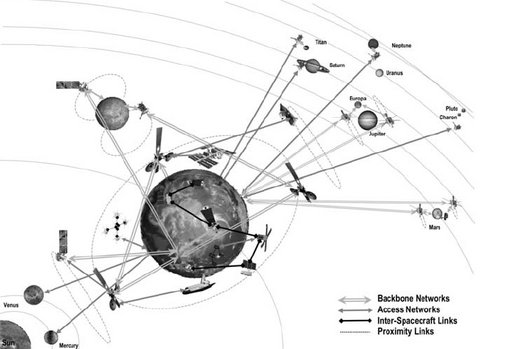[/caption]
Communication with spacecraft is vital for NASA, and since the World Wide Web has enabled easy, reliable and quick contact for people around the world, the space agency decided to model a new deep space communication system on the internet. A month-long test of this “Interplanetary Internet” was successfully conducted by transmitting dozens of images to and from the EPOXI spacecraft, now about 20 million miles from Earth. The system uses software called Disruption-Tolerant Networking, or DTN created by a partnership between NASA and Google vice president Vint Cerf. “This is the first step in creating a totally new space communications capability, an interplanetary Internet,” said Adrian Hooke, team lead and manager of space-networking architecture, technology and standards at NASA Headquarters in Washington.
NASA’s current communication system, the Deep Space Network, has been around since the early days of space travel, and NASA is looking to upgrade and enhance their ability to communicate with spacecraft. The Interplanetary Internet must be robust to withstand delays, disruptions and disconnections in space. Glitches can happen when a spacecraft moves behind a planet, or when solar storms and long communication delays occur. The delay in sending or receiving data from Mars takes between three-and-a-half to 20 minutes at the speed of light. Therefore, the DTN sends information using a method that differs from the normal Internet’s Transmission-Control Protocol/Internet Protocol, or TCP/IP, communication suite, which Cerf also co-designed.
Unlike TCP/IP on Earth, the DTN does not assume a continuous end-to-end connection. In its design, if a destination path cannot be found, the data packets are not discarded. Instead, each network node keeps the information as long as necessary until it can communicate safely with another node. This store-and-forward method, similar to basketball players safely passing the ball to the player nearest the basket means information does not get lost when no immediate path to the destination exists. Eventually, the information is delivered to the end user. This is all done automatically.
Engineers began a month-long series of DTN demonstrations in October. Data were transmitted using NASA’s Deep Space Network in demonstrations occurring twice a week. Engineers use NASA’s EPOXI spacecraft as a Mars data-relay orbiter. EPOXI spacecraft is the bus from the Deep Impact mission that send an impactor to Comet Temple 1 in July of 2005, and it is now on a mission to encounter Comet Hartley 2 in two years. There are 10 nodes on this early interplanetary network. One is the EPOXI spacecraft itself and the other nine, which are on the ground at JPL, simulate Mars landers, orbiters and ground mission-operations centers.
This month-long experiment is the first in a series of planned demonstrations to qualify the technology for use on a variety of upcoming space missions. As Ian reported last month, the next round of testing will be done on the International Space Station next summer.
In the next few years, the Interplanetary Internet could enable many new types of space missions. Complex missions involving multiple landed, mobile and orbiting spacecraft will be far easier to support through the use of the Interplanetary Internet. It also could ensure reliable communications for astronauts on the surface of the moon.
Source: NASA


While the Internet made such a huge progress from ancient DARPAnet to current World Wide Web, it also lost so much of uplifting communication in form and content. “Proletarianization” occured, spam is flooding eMail-accounts, salacious offers thread self-concepts, everybody is invited to publish absolutelly irrelevant expressions of themselves, rampant cynism dominates “discussion” forums …
The brilliancy of technological masterstrokes is made available to human voidness while the meaning of the word “communication” comprises so much of shortcoming and of menace of cultural basics.
So now our scientific avantgarde is engineering a new interplanetary internet? ;))))))
Does this mean I’ll be able to use Google maps to help solve the “Where in the Universe” challenges? 🙂
Good one, RL!
I hope this can be made to work. It does seem a bit silly that we still have to time communications according to where we can point a handful of disks. I’m looking forward to the day we have big ‘servers’ running in Moon and Mars orbit.
Glad to see progress is being made in the Interplanetary Internet. It definitely is the communication way of the future for our next gen spacecrafts. Radio is fine and dandy and robust, but we all know its limitations.
dollhopf, I hear your worries, but I think we’re safe from that until a Universe-Wide-Web is created on the Internplantery Internet. And for that, we’ll have to have humans or other life forms living in far off places who surf the UWW and blog about their irrelevant experiences 🙂
hmm perhaps it would be good to have a transmission priority level built in.
dollhopf – ” rampant cynism dominates “discussion” forums … ” – an ironic comment
Where can I find a larger, readable, version of that picture?
Google [ How to overrun pitiful human race ]
Results 1 – 10 of about 120,000 for how to overrun pitiful human race. (0.29 seconds)
oops, hope they’ve got some filtering software installed .. !
kvenlander:
Google is your friend 😉
http://www.tobedetermined.org/images/space%20internet%20network.png
(only slightly bigger, but is more readable)
tek_604
I have no idea what operating systems will be run on the machines that once will be connected to the Interplanetary Internet. So kvenlander can also zoom parts of the picture is with MS Windows’ display utility “Magnifier” (magnify.exe):
http://www.microsoft.com/windowsxp/using/accessibility/magnifierturnon.mspx
RL Says:
November 19th, 2008 at 9:48 am
Does this mean I’ll be able to use Google maps to help solve the “Where in the Universe” challenges?
Maybe not, but spam about “Sexy Naked Alien Martian Robots” probably isn’t that far off. 😀
I would guess this would be a closed network so we don’t have to worry about the Mars rovers getting a virus or hackers turning Cassini into a spam spewing zombie probe.